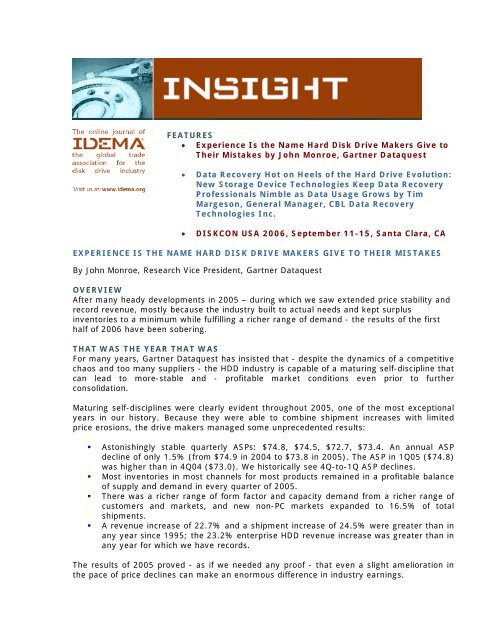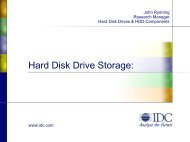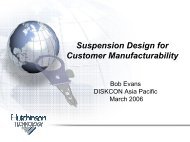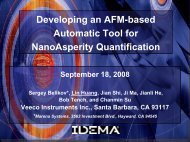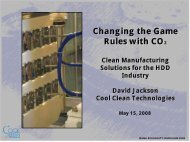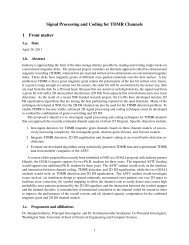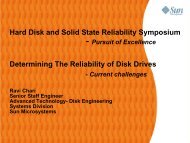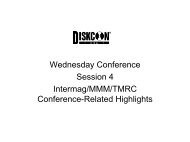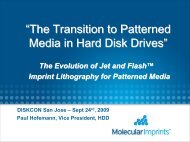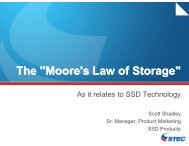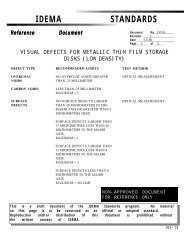FEATURES • Experience Is the Name Hard Disk Drive ... - IDEMA
FEATURES • Experience Is the Name Hard Disk Drive ... - IDEMA
FEATURES • Experience Is the Name Hard Disk Drive ... - IDEMA
- No tags were found...
Create successful ePaper yourself
Turn your PDF publications into a flip-book with our unique Google optimized e-Paper software.
<strong>FEATURES</strong><strong>•</strong> <strong>Experience</strong> <strong>Is</strong> <strong>the</strong> <strong>Name</strong> <strong>Hard</strong> <strong>Disk</strong> <strong>Drive</strong> Makers Give toTheir Mistakes by John Monroe, Gartner Dataquest<strong>•</strong> Data Recovery Hot on Heels of <strong>the</strong> <strong>Hard</strong> <strong>Drive</strong> Evolution:New Storage Device Technologies Keep Data RecoveryProfessionals Nimble as Data Usage Grows by TimMargeson, General Manager, CBL Data RecoveryTechnologies Inc.<strong>•</strong> DISKCON USA 2006, September 11-15, Santa Clara, CAEXPERIENCE IS THE NAME HARD DISK DRIVE MAKERS GIVE TO THEIR MISTAKESBy John Monroe, Research Vice President, Gartner DataquestOVERVIEWAfter many heady developments in 2005 – during which we saw extended price stability andrecord revenue, mostly because <strong>the</strong> industry built to actual needs and kept surplusinventories to a minimum while fulfilling a richer range of demand - <strong>the</strong> results of <strong>the</strong> firsthalf of 2006 have been sobering.THAT WAS THE YEAR THAT WASFor many years, Gartner Dataquest has insisted that - despite <strong>the</strong> dynamics of a competitivechaos and too many suppliers - <strong>the</strong> HDD industry is capable of a maturing self-discipline thatcan lead to more-stable and - profitable market conditions even prior to fur<strong>the</strong>rconsolidation.Maturing self-disciplines were clearly evident throughout 2005, one of <strong>the</strong> most exceptionalyears in our history. Because <strong>the</strong>y were able to combine shipment increases with limitedprice erosions, <strong>the</strong> drive makers managed some unprecedented results:<strong>•</strong> Astonishingly stable quarterly ASPs: $74.8, $74.5, $72.7, $73.4. An annual ASPdecline of only 1.5% (from $74.9 in 2004 to $73.8 in 2005). The ASP in 1Q05 ($74.8)was higher than in 4Q04 ($73.0). We historically see 4Q-to-1Q ASP declines.<strong>•</strong> Most inventories in most channels for most products remained in a profitable balanceof supply and demand in every quarter of 2005.<strong>•</strong> There was a richer range of form factor and capacity demand from a richer range ofcustomers and markets, and new non-PC markets expanded to 16.5% of totalshipments.<strong>•</strong> A revenue increase of 22.7% and a shipment increase of 24.5% were greater than inany year since 1995; <strong>the</strong> 23.2% enterprise HDD revenue increase was greater than inany year for which we have records.The results of 2005 proved - as if we needed any proof - that even a slight amelioration in<strong>the</strong> pace of price declines can make an enormous difference in industry earnings.
It’s been different in 2006. ASP has declined from $73.4 in 4Q05 to $72.2 in 1Q06 to $68.8in 2Q06. Inventories, though far from unwieldy, have displayed some awkward imbalances.After three successive quarters of revenue above $7 billion, industry revenue dipped to $6.8billion in 2Q06. And, subsequent to Seagate’s announcement of its intent to purchase Maxtorin December 2005 and <strong>the</strong> consummation of <strong>the</strong> merger in May 2006, we have seen someirrationally fierce contention for market share, particularly in <strong>the</strong> distribution channels,resulting in some needless price erosions (more on this later). Although hardly surprising for<strong>the</strong> first half of <strong>the</strong> year - historically, it’s “normal” and to be expected; in 2002, 2003 and2004, respectively, 4Q-to-2Q HDD industry ASP declined as follows: $96.2->$86.9->$83.7,$86.2->$85.5->$80.7 and $78.9->$76.1->$72.4) - this is surely disappointing compared to<strong>the</strong> extraordinary results of 2005.Tables 1 and 2 below detail some top-level HDD industry history for <strong>the</strong> past nine quarters.Table 1Quarterly HDD Shipments and inventory Changes, 2Q04 to 2Q062Q04 3Q04 4Q04 1Q05 2Q05 3Q05 4Q05 1Q06 2Q06Shipments 67,456 79,153 89,118 88,263 90,030 96,580 105,396 102,159 99,450Change(%) (3.1) 17.3 12.6 (1.0) 2.0 2.0 9.1 (3.1) (2.7)Inventory 20,280 21,539 20,390 19,889 21,190 21,933 22,551 23,755 22,998Change(%) 5.3 6.2 (5.3) (2.5) 6.5 3.5 2.8 5.3 (3.2)Inv./Ship.(%) 30.1 27.2 22.9 22.5 23.5 22.7 21.4 23.3 23.1Note: “Inventory” is an estimate of <strong>the</strong> combined total of drives in all distribution channeland OEM JIT warehouses only, excluding work-in-progress and finished goods in o<strong>the</strong>rvendor warehouses and factories. Source: Gartner Dataquest (August 2006)Table 2Quarterly HDD Revenue and ASP Changes, 2Q04 to 2Q062Q04 3Q04 4Q04 1Q05 2Q05 3Q05 4Q05 1Q06 2Q06Revenue (inUSD millions) 5,134 5,727 6,509 6,599 6,703 7,019 7,738 7,374 6,838SequentialChange (%) (6.6) 11.6 13.7 1.4 1.6 1.6 10.2 (4.7) (7.3)ASP (in USD) 76.1 72.4 73.0 74.8 74.5 72.7 73.4 72.2 68.8SequentialChange (%) (3.9) (4.9) 0.8 2.5 (0.4) (0.4) 1.0 (1.7) (4.7)Note: “ASP” is <strong>the</strong> average selling price for all classes of HDDs.Source: Gartner Dataquest (August 2006)Despite some unnecessary price aggression in <strong>the</strong> desktop and mobile arenas, <strong>the</strong>re are alsomany bright spots. With only three suppliers, no excess inventories and continuing realdemand in excess of 6.5 million units per quarter, enterprise markets are profitable andpricing is as stable as it has ever been. Partially because <strong>the</strong>re was curtailment of desktopand mobile build and ship plans by some vendors in June, we estimate that 2Q06 OEM JITwarehouse and distribution channel inventories declined sequentially for <strong>the</strong> first time since1Q05, setting <strong>the</strong> stage for a more profitable balance of supply and demand in <strong>the</strong> back halfof <strong>the</strong> year. And mid-quarter reports indicate that demand is expanding in all markets;shipments of 110.7 million drives in 3Q06 and 120.6 million drives in 4Q06 (our currentestimates) should meet, and not exceed, evolving demand, <strong>the</strong>reby engendering morelucrativemarket conditions.
We foresee many opportunities for profitable growth in 2H06 and beyond. But <strong>the</strong> drivemakers must cast a cold eye on some of <strong>the</strong> more disturbing aspects of <strong>the</strong>ir recent historyand change some self-destructive tendencies.A PROFUSION OF REBATES AND DOWNWARD PRICING SPIRALSAs expected, mobile and desktop mainstream pricing became more aggressive in 1H06, butin some cases was unexpectedly and unnecessarily combative. To cite only two examples:<strong>•</strong> During 2Q06, 80GB/7200-rpm desktop 3.5” pricing dropped to below $40 for somemajor deals; pricing for this class of product certainly could have remained in <strong>the</strong>profitable range of $43-to-$48 for all channels, but it did not.<strong>•</strong> During 2Q06, 40GB/5400-rpm mobile 2.5” pricing dropped to below $43 for somemajor deals; pricing for this class of product certainly could have remained in <strong>the</strong>profitable range of $46-to-$51 for all channels, but it did not.What we saw in 1Q06 and continued to see in 2Q06 were fur<strong>the</strong>r embodiments of Monroe’sLaw III: “Market share for <strong>the</strong> sake of market share + disinformation throughout <strong>the</strong> supplychain = a sludge of needlessly wasted profits.”By a combination of disinformation and <strong>the</strong> pursuit of market share for <strong>the</strong> sake of marketshare, <strong>the</strong> industry managed to sell many mainstream mobile and desktop HDDs at $3-to-$5less than was strictly required by any mindful strategic imperative. There have been noshare shifts of any meaningful or lasting value, certainly not in <strong>the</strong> distribution channels,where <strong>the</strong> price wars have been most fiercely fought.Surplus channel inventories, coupled with distribution price declines and a multitude ofspecial quarter-end deals, are “standard procedure” in March and June of almost every year.This changed in 2005. Partially because of media shortages combined with increaseddemand, distribution channel inventories were kept to a minimum and <strong>the</strong> drive makersmanaged to keep special distribution deals to a minimum.What happened in 2006? A major merger proposal (Seagate’s purchase of Maxtor) wasannounced in December 2005, and some surprisingly aggressive price moves becameapparent in late January and early February 2006 (ra<strong>the</strong>r than in mid-to-late March, whichwould have been “normal”). These price moves were not in apparent response to anyinventory pressure - we did see some surplus inventories at <strong>the</strong> end of March, but in Januaryand February inventories were closely aligned to run rates (as opposed to swelling toward asurplus state, which would have been “normal”). Ra<strong>the</strong>r, we believe that distribution desktoppricing heated up as a result of a deluded quest on multiple fronts to proactively “sew up” -or perhaps “sow up” is more accurate, since channel management was effectively makingsow’s ears out of silk purses - <strong>the</strong> potential desktop share that would become available asMaxtor got absorbed into Seagate.Trying to shift a quarterly or annual share merely by means of aggressive price has alwaysbeen a sign of senseless marketing and wasted resources (or badly constructed salescommission programs). I should know; prior to becoming a Gartner analyst, I had to dealwith insane pricing almost every day during my 1980-to-1997 career in <strong>the</strong> “dirty ditches of<strong>the</strong> VAR channel,” and it was almost always impossible to know with certainty whe<strong>the</strong>r aprice reduction was necessary or needless. But I did learn this: Whatever distribution shareyou manage to buy for, say, $3 this week can be bought for $4 next week by your arch rivaland <strong>the</strong>n must be repurchased for $5 <strong>the</strong> following week (by you or some o<strong>the</strong>r low-bid
competitor). Despite <strong>the</strong>ir protestations to <strong>the</strong> contrary (when <strong>the</strong>y want to curry favor witha particular vendor), <strong>the</strong> distribution brokers and high-volume system integrators in <strong>the</strong>channel, who purchase a high percentage of <strong>the</strong> total distribution volume, are largely loyal toprice and not to any particular vendor (since most desktop drives in most desktop systemsare mostly interchangeable most of <strong>the</strong> time). But it is also true that many large customersare, in fact, loyal to particular vendors, but threaten to change vendors constantly (with noreal intention of doing so), <strong>the</strong>reby managing to play one distributor off ano<strong>the</strong>r to obtainlower prices by means of lies and misdirection (and, in many cases, effectively managing tomake a vendor compete against itself). All major distributors and <strong>the</strong>ir major customershave become masterful at claiming - and double-claiming - vendor rebates, whe<strong>the</strong>r earnedor unearned.The more rebates <strong>the</strong>re are, <strong>the</strong> more chance <strong>the</strong>re is of paying an illegitimate claim. Aprofusion of rebates always generates a downward pricing spiral. And any accelerateddownward spiral caused by a frenzy of disinformation churned up by distributors and <strong>the</strong>irhigh-volume customers is always profitless and non-strategic, clearly an example of <strong>the</strong>drive makers collectively practicing short-term tactics at extreme odds with <strong>the</strong>ir statedlong-term strategic aims.The difference between dropping price to maintain share as opposed to dropping price togain share is irrelevant in this atmosphere. There is no “moral high ground” and <strong>the</strong>re is nosuch thing as an “innocent bystander.” And it really does not matter who fired <strong>the</strong> first shot.What’s more important is who fired <strong>the</strong> second, third and fourth shots, and why <strong>the</strong>y“believed” <strong>the</strong>y “had” to fire <strong>the</strong>m. All players are perpetrators.On <strong>the</strong> bright side, pricing now seems to have stabilized (albeit at needlessly low levels), andwe expect burgeoning demand in legacy and emerging markets throughout 2H06. A richermix of qualified high-end mobile and desktop products sold to a more-diverse customer basecan substantially offset low-end price erosions - this proved true for some vendors in 1H06and should certainly be an increasing factor in 2H06 industry profitability.Meanwhile, <strong>the</strong> enterprise markets have never been healthier. The industry set a new recordat 6.929 million units in 2Q06, pricing is stable, <strong>the</strong>re is no evidence of any surplusinventories, and 2H06 demand from <strong>the</strong> key enterprise OEMs seems solid and predictable.Shipments of SCSI-, SAS- and FC-interface HDDs could increase to more than 27.5 millionunits in 2006.We had hoped that <strong>the</strong> merger of Seagate and Maxtor would help to usher in a new era ofsustained profitability and wiser market management. The potential for win/win marketshare shifts was (and still is) substantial: The number of desktop HDD suppliers has beenreduced from five to four, <strong>the</strong> number of enterprise HDD suppliers has been reduced fromfour to three, and Seagate’s stated aim is to try to retain only 50 percent (best case) ofMaxtor’s revenue, leaving plenty of room for <strong>the</strong> surviving desktop and enterprise drivemakers to profitably garner increased share. To date, and disappointingly, <strong>the</strong>announcement of this merger and its consummation have generated more ra<strong>the</strong>r than lesschaos and pricing instability in <strong>the</strong> desktop HDD markets.Many investors once again have become wary, and - with good reason - once again havebegun to doubt <strong>the</strong> supposedly growing maturity of this industry.GETTING (ONLY) WHAT YOU PAY FORSurely at least one sign of maturity is <strong>the</strong> degree of integrity inherent in <strong>the</strong> decisions madeby a person, group, company or industry. From this perhaps limited perspective, <strong>the</strong> HDD
industry is still immature. With few exceptions, <strong>the</strong> drive makers have seldom, individually oras a group, displayed consistent courage, conviction or integrity with regard to pricing andmarket management.This has changed much for <strong>the</strong> better in recent years, and some drive makers – mostnotably Seagate and Western Digital – have reported consistent and record-setting profits.However, in recent months, profitability as a strategic aim once again has been underminedby tactical behaviors in certain markets that have decimated possibilities for more-lucrativebusiness engagements. Compounding <strong>the</strong> vagaries exhibited by fervid grapplings for marketshare have been <strong>the</strong> drive makers' collective tendencies to allow major customers to getwhatever <strong>the</strong>y want whenever <strong>the</strong>y want it.Most major HDD customers can behave tactically (to obtain <strong>the</strong> best daily price) orstrategically (to obtain, among o<strong>the</strong>r things, guaranteed allocation in tight times) withoutbeing required to extend, in return, adequate commitment to or partnership with a vendor.In most mature industries, one eventually gets only what one pays for. In <strong>the</strong> HDD industry,<strong>the</strong> major customers almost always get much more than <strong>the</strong>y are willing to pay for.There has been growing strategic alliance in recent years, with more examples of sharedrisks and shared rewards among vendors and customers throughout <strong>the</strong> supply chain, butHDD vendors still seem to be more at <strong>the</strong> mercy of <strong>the</strong>ir major customers than in o<strong>the</strong>rmaturing industries.As industry consolidation progresses, vendors and customers must soon decide between twodistinct forms of dealing with each o<strong>the</strong>r. Will we continue to be more completely defined byan irrational, cut-throat competition or by a more highly evolved, open and efficientsymbiosis on a large scale? As persons, groups and companies, we cannot have it both ways,depending on whim and circumstance. We must choose. And we must recognize that ourchoices will have inescapable consequences.TACTICAL DEALS OF THE DAYMany major HDD customers have been auctioning <strong>the</strong>ir available volumes to <strong>the</strong> lowestbidder. Auctions may occur with precise planning or unexpectedly. Auctions encouragedistrust, disinformation, fear, tactical share shifts and frequent price reductions. Auctionsdiscourage trust, clarity, alliance and any long-term strategic commitment.If a major customer demands <strong>the</strong> right to have continuous tactical access to <strong>the</strong> best deal of<strong>the</strong> day during times of relative surplus, <strong>the</strong>n this same customer should not be granted <strong>the</strong>privilege of stable price and strategic support during times of relative scarcity of product. To<strong>the</strong>ir detriment, <strong>the</strong> drive makers have let <strong>the</strong> tactical deal-of-<strong>the</strong>-day players have <strong>the</strong> bestprice and <strong>the</strong> best service and support in times of surplus as well as in times of scarcity.No appreciable loyalty has been engendered by this practice of generous accommodation.Since strategic support and acceptable quality and performance are taken for granted, majorcustomers generally consider an HDD vendor to be only as good as <strong>the</strong> best available price.In turn, HDD vendors consider <strong>the</strong>ir suppliers to be only as good as <strong>the</strong> best available price.Occasionally <strong>the</strong> best available technology or quality wins, irrespective of price, but thisseems to be happening with decreasing frequency. To say that price has become increasingly<strong>the</strong> final arbiter in every deal may be a calculated and obvious overstatement, but it remainsdisturbingly true throughout <strong>the</strong> supply chain. The drive makers almost always cave in tobrutal pricing pressures from <strong>the</strong>ir major customers, even when prevailing market conditionswould permit more-sensible ASP management, and <strong>the</strong>n put an inordinate, bankruptingpressure on <strong>the</strong>ir suppliers.
The thing about <strong>the</strong> best deal of <strong>the</strong> day that HDD makers and major customers have failedto acknowledge is that this deal may be low or it may be high compared to <strong>the</strong> previous day;<strong>the</strong> sword must cut both ways for vendors and customers. If one plays <strong>the</strong> deal-of-<strong>the</strong>-daygame, <strong>the</strong> rules should stipulate that <strong>the</strong> price must be solely dependent on <strong>the</strong> specificcircumstances of <strong>the</strong> day. Scarcity creates value. During days of scarcity, <strong>the</strong> price must goup, and <strong>the</strong> customer must expect to pay more (at times significantly more) to obtaindesirable allocations of product.Price fluctuations up and down are a vital part of playing <strong>the</strong> game of cut-throat competitionwith integrity. Price protections are rare, as are strategic privileges in times of need.In this game, only he who has <strong>the</strong> most blood can live for long. Very few players will survive.Those surviving players may become insatiably greedy and major customers may be amazedby <strong>the</strong> destructive power of <strong>the</strong>ir appetites. What goes around eventually comes around…MATURE AND ENDURING ALLIANCESA certain degree of feral competition may be inevitable (even desirable), but a deepcommitment to <strong>the</strong> creation of more mature and enduring alliances may be <strong>the</strong> only thingcapable of showing us <strong>the</strong> ways in which fair and sustainable profits can become a reality in<strong>the</strong> HDD industry. In this hopeful scenario, all drive makers will maintain and enhance allrelationships at each stage of <strong>the</strong> supply chain by developing in-depth, confidential, mutuallybeneficial partnerships with carefully chosen vendors and strategic customers. For suchalliances to be truly effective, at least a few major customers must become less-adversarialparticipants in <strong>the</strong>se evolving relationships.Those that choose to play <strong>the</strong> strategic alliance game should play with integrity. The optionof reverting midstream to feral tactics for expediency and convenience should be shunned.In <strong>the</strong> game of strategic alliance, all vendors must -- in exchange for long-term, mutualcommitments -- deliver consistent service to <strong>the</strong>ir chosen strategic customers and resist <strong>the</strong>temptation to arbitrarily raise (or lower) prices or unfairly allocate product to higher-payingcustomers when changing market conditions permit.Tactical manipulation should not be rewarded with strategic levels of service, and valuedstrategic partnerships should not be degraded by tactical manipulation.MANAGING A NEW ERA OF LOWER PRICESIt's strange and sobering to think that, in early 1998, coming off one of <strong>the</strong> worst years inindustry history, facing an enormous inventory overhang in excess of 35 percent of quarterlyshipments, <strong>the</strong> drive makers were wracked with fear and loathing, wondering how <strong>the</strong>y couldprofitably build drives for $89 to $99 to satisfy <strong>the</strong> craze for sub-$1,000 computers. In 1998,no one we talked to imagined that profits could be made at sub-$80, much less sub-$60,ASPs. But <strong>the</strong> industry managed to prove its resiliency and operational brilliance, cuttingproduction costs and increasing per-platter capacities while simultaneously decreasing powerrequirements and increasing performance, ruggedness and reliability in a growing variety ofdesigns and form factors. After great pain and many setbacks, and partially because drivemakers managed build plans and inventories with greater wisdom, <strong>the</strong> industry learned howto be profitable with sub-$50 ASPs for entry-level mobile and desktop HDDs.However, in recent months, and in stark contrast to 2005, <strong>the</strong> drive makers managed asusual to lower entry-level HDD prices to mostly profitless levels.
Oscar Wilde once wrote: "<strong>Experience</strong> is <strong>the</strong> name people give to <strong>the</strong>ir mistakes." The HDDindustry is experienced enough to know how to act wisely. But our recent behavior wouldindicate that few industry players can be sanely accused of enlightened self-interest.SOME DEEPER RECKONINGThe year 1988 seems a reasonable starting point for developments that led from an era ofcontinuous expansion of HDD vendors to an era of widespread HDD industry consolidation.We had some trouble determining precisely how many companies were producingproprietary HDD designs in 1988. Some sources claim that <strong>the</strong>re were more than 60 drivecompanies in 1988, but this number usually includes optical and floppy disc drive makers aswell as HDD makers. We did manage to uncover one hard fact: At <strong>the</strong> Fall Comdex show inLas Vegas in November 1987, 28 companies announced proprietary new HDD designs thatwere destined to be built in 1988. We conservatively guess that <strong>the</strong>re were at least seveno<strong>the</strong>r smaller drive makers who did not exhibit at this show. We <strong>the</strong>refore believe that wereat least 35 companies in 1988 that designed and manufactured proprietary HDDs. Thesecompanies delivered a mere 15.8 million drives during that year.Now <strong>the</strong>re are only 7 major suppliers (only four for desktop HDDs). In 2005 <strong>the</strong>se companiesshipped 380.3 million drives (239.8 million of which were desktop HDDs, up from 209.2million in 2004). Since 1988, <strong>the</strong> markets for HDDs have grown enormously (and willcontinue to grow), and <strong>the</strong> number of HDD suppliers has dramatically declined.These developments should have created -- within <strong>the</strong> legal limits of free enterprise -- somekind of constructive, cooperative incentive for strategically lucrative business endeavors. Andyet <strong>the</strong> industry still finds itself incapable of producing consistent profits. History has shownus that -- despite <strong>the</strong> favorable chances created by expanding markets -- consolidation, inand of itself, will not be sufficient to change <strong>the</strong> HDD industry’s tendency to engage inprofitless pricing practices. Some deeper reckoning will be required.A FUTURE OF CONSISTENTLY PROFITABLE COMPETITIONS?The Navajo Indians used to say that coyotes were too wise to engage in hopelesscompetitions.For much of <strong>the</strong> last decade, most hard disk drive makers, from a fiscal perspective, havebeen too foolish to engage in anything but hopeless competitions, behaving more likelemmings, who routinely, and for no apparent reason (except, perhaps, for populationcontrol), commit spontaneous mass suicide by running over <strong>the</strong> edge of cliffs.We’ve seen some recent price wars, but <strong>the</strong>y pale in comparison to our colorful past. To ourmind, <strong>the</strong> most stunning example of irrational behavior would be <strong>the</strong> desktop price wars ofJune 1999, during which low-end desktop pricing dropped more than 20 percent in less thantwo weeks. When <strong>the</strong> smoke had cleared, we saw no meaningful share shifts and no winners(at least among <strong>the</strong> drive makers: <strong>the</strong> OEMs “won” some incredible, prematurely low prices),we saw only decimated profits…This will change. It already has changed. Throughout 2005, we saw more executives anddirectors at more companies at more levels in <strong>the</strong> supply chain making consistent decisionsto manage for profit, not market share. And in 2006, despite some toughly twisted andturbulent contentions for market share, a few drive makers managed to report substantialprofits. In <strong>the</strong> past, such contentions would have decimated profits for <strong>the</strong> entire industry.There is always <strong>the</strong> danger of history repeating itself (as it did to some degree during <strong>the</strong>
first two quarters of 2006), but we still believe that <strong>the</strong> largest HDD makers, with a freshlyminted balance of operational excellence and fiscal wisdom, are now poised and determinedto engage only in consistently profitable competitions.If not, if we are wrong about this, <strong>the</strong>n – obviously - <strong>the</strong> industry’s chances for morereasonableand judiciously expanded future earnings will be diminished. As Dan Quayle oncesaid, “If we don’t succeed we run <strong>the</strong> risk of failure.”ENORMOUS OPPORTUNITIESThe natural world has always been a network of complicated and intricately interdependentecosystems. In recent years, pervasive computing has transformed a large part of ourhuman world, and we have created a gigantic network - literally, a worldwide web - forefficient data exchange.The ease of accessing data is increasing and <strong>the</strong> speed of access to data is accelerating.Local and global networks will continue to expand. A typical user will manipulate multiplekinds of personal and business data at multiple locations using multiple devices. Broadcastdata - from emails to television programs, spreadsheets to movies, legal and financialdocuments to songs - will be increasingly “captured” and stored on stationary and portablesystems. In many guises, and bi-directionally, <strong>the</strong> “enterprise” will become part of <strong>the</strong>“fabric” of our daily lives, and <strong>the</strong> “fabric” of our daily lives will become part of <strong>the</strong>“enterprise.” From <strong>the</strong> consumer to <strong>the</strong> data center: Living rooms, automobiles, portablemedia players, cell phones and <strong>the</strong> traditional realms of enterprise computing willincreasingly reflect <strong>the</strong> same global network.The kind and capacity of storage devices needed in this network will depend upon <strong>the</strong> sizeand shape and extent of commercial and consumer computing and entertainmentenvironments, which in turn will depend upon <strong>the</strong> bandwidth and ubiquity of wired andwireless networks and <strong>the</strong> variety and affordability of <strong>the</strong> kinds of content that can beaccessed and downloaded.It’s very hard to make sensible predictions of how that kind of seething turmoil will evolve.However, several trends are clear and not likely to change:<strong>•</strong> Consumers throughout <strong>the</strong> world have demonstrated an almost insatiable desire toview movies and listen to digital music at home and on <strong>the</strong> road.<strong>•</strong> The digitization of <strong>the</strong> world's cultural artifacts is still in its infancy.<strong>•</strong> New directions and dimensions in networking and corporate compliance will demandgreater storage capacity and quick, seamless access to huge databases.Most if not all of <strong>the</strong> perceptible trends in commercial and consumer uses of digital datapoint toward a steadily increasing demand for multiple kinds of HDDs from multiple storagemarkets.At no time in history has Gartner Dataquest seen greater chances for profitable HDD industrygrowth.It will be a sad and preventable waste if <strong>the</strong> surviving drive makers persist in failing to takefull competitive advantage of <strong>the</strong>ir enormous opportunities.
About <strong>the</strong> Author: John MonroeMr. Monroe is a research vice president in <strong>the</strong> Storage Group at Gartner. He is responsiblefor tracking all aspects of <strong>the</strong> hard disk drive industry, including technology and markettrends as well as financial results. Mr. Monroe has established a reputation as an eloquent,imaginative industry spokesperson, has been quoted in many newspapers and magazines,including Forbes, <strong>the</strong> Wall Street Journal and <strong>the</strong> New York Times, and has been an invitedspeaker at conferences in Japan, Singapore, Thailand, China, France and <strong>the</strong> United States.Mr. Monroe has been involved with disk drive sales, product management and marketanalysis for more than 25 years. Unlike many analysts, Mr. Monroe has had extensiveexperience as a business line manager, responsible for <strong>the</strong> profitable purchase and resale ofdisk and tape products. Prior to joining Gartner in October 1997, Mr. Monroe spent sevenyears as vice president of storage products at SYNNEX Information Technologies (where,among o<strong>the</strong>r duties, he coordinated <strong>the</strong> flow of more than two million hard disk drives peryear), two years as director of North American sales and marketing for Kalok Corporation,five years as vice president of OEM products and sales for Media Winchester Ltd., and threeyears as a general manager at Electrolabs, a small distribution company, where he began hiselectronics career in 1980 by selling hybrid ICs and 8-inch floppy disc drives.Mr. Monroe earned a bachelor’s degree Phi Beta Kappa, summa cum laude from AmherstCollege in 1976 and also earned a master's degree in fine arts with honors from ColumbiaUniversity in 1980.DATA RECOVERY HOT ON HEELS OF THE HARD DRIVE EVOLUTIONNew storage device technologies keep data recovery professionals nimble as data usagegrowsBy Tim MargesonGeneral Manager, CBL Data Recovery Technologies Inc.Industries have given birth to new industries; new technologies create <strong>the</strong> need for o<strong>the</strong>rtechnologies and services. Such is <strong>the</strong> case with data recovery. The evolution of datarecovery has been driven by <strong>the</strong> innovation in data storage technologies.With <strong>the</strong> hard drive celebrating its 50 th anniversary, <strong>the</strong> discipline of data recovery hascontinued to stay abreast of data storage technology improvements. However, <strong>the</strong> history ofprofessional data recovery is somewhat shorter and it hasn’t been until <strong>the</strong> past decade or sothat <strong>the</strong> data stored in a computer system has become more valued than <strong>the</strong> hardware itself.The first commercially available hard drive held only five megabytes of data, and it wasn’tuntil <strong>the</strong> 1990s that hard drives ranging in capacity from 20MB at <strong>the</strong> start of <strong>the</strong> decade to20GB by <strong>the</strong> end became widespread. That availability, particularly for individuals and smallandmedium-sized businesses, meant more and more indispensable data was finding its wayon to computers.As with any commoditized technology, <strong>the</strong> cost of hard drives began progressively droppingin 1994. Whe<strong>the</strong>r or not <strong>the</strong> hardware could be repaired became less relevant than whe<strong>the</strong>ror not <strong>the</strong> data could be resurrected.It’s this “flip flop” that has given birth to <strong>the</strong> discipline now known today as data recovery.
As <strong>the</strong> personal computer market matured, computer systems were actively adopted bybusinesses to <strong>the</strong> point now where almost every employee in an office has a computer on<strong>the</strong>ir desk and frequently one or more at home. Even retail operations were finding reasonsto have computers at service counters.WHERE DATA GOES, THREATS FOLLOWWith computers everywhere, information was facing all sorts of threats it had never facedbefore. While <strong>the</strong> storage technology itself has become highly reliable, <strong>the</strong>re are stillexternal, unpredictable threats that cause damage to hard drives and lead to data loss.Physical damage remains one of <strong>the</strong> most common threats to computers, whe<strong>the</strong>r it’s apersonal computer at home, a laptop used for <strong>the</strong> business traveler, or a high-end servertucked away in a corporate data center.Mo<strong>the</strong>r Nature is one of <strong>the</strong> worse offenders – storm damage can have a devastatingphysical impact on computer hardware. While power surges and power outages are morefrequent, flood damage is often <strong>the</strong> worse culprit because it doesn’t occur to individuals andbusinesses that flood levels could ever reach <strong>the</strong>ir hardware. The environment where a harddrive is stored is critical to <strong>the</strong> drive’s longevity. Insufficient air cooling and circulation cancause <strong>the</strong> best technology to overheat.While servers and desktops are rarely physically handled, laptops now account for more thanhalf of computers sold, and users often forget that despite <strong>the</strong>ir smaller form factor andlighter weight, mobile computers are delicate pieces of equipment. Even <strong>the</strong> most ruggedlydesigned laptops still need to be handled appropriately. Physical damage always causes <strong>the</strong>vast majority of severe data loss problems. However, software, or logical, problems can bejust as ruthless. Logical damage can be caused by even <strong>the</strong> most innocent of situations.Incorrectly shutting down a computer can prevent <strong>the</strong> file system from accurately reallocatingphysical data blocks at <strong>the</strong> end of <strong>the</strong> user’s session. This can lead to a variety ofproblems, such as invalid partition tables, drives reporting negative amounts of free space,system crashes or corrupted data.Viruses are also a very common threat to hard drives. While some of <strong>the</strong>m only affect <strong>the</strong>performance of an operating system, some viruses are specifically designed to delete data orcorrupt partitions and file systems. Insufficient protection because of poorly configured orupdated anti-virus software and firewalls can overcome <strong>the</strong> best hardware fail safes as canpoor user behavior. Employees opening an e-mail attachment <strong>the</strong>y don’t recognize can be afrequent destroyer of important business data.Most damage, whe<strong>the</strong>r it is physical or logical, cannot be repaired by end users and that’swhere <strong>the</strong> data recovery specialist comes into <strong>the</strong> picture. Opening a hard disk in a normalenvironment will allow dust to settle on <strong>the</strong> platter surfaces, causing fur<strong>the</strong>r damage to <strong>the</strong>platters and <strong>the</strong>reby complicating <strong>the</strong> entire recovery process. In addition, end usersgenerally do not have <strong>the</strong> hardware or technical expertise required to repair hard drives.DATA VALUE RISINGUntil <strong>the</strong> mid-90s, most users would simply take <strong>the</strong>ir hard drive to a service depot andresign <strong>the</strong>mselves that some of <strong>the</strong>ir valuable information was lost forever.
As hard drives were relatively costly at <strong>the</strong> time, repair made financial sense. However, likemany electronic devices, <strong>the</strong> cost of <strong>the</strong> hard drives came down to a point where replacing<strong>the</strong> drive was more reasonable than just a repair; hard drive repair shops found <strong>the</strong>mselveshaving to adapt or face oblivion.This do or die situation is in part why many data recovery techniques stem from processesused to repair hard drives. Understanding <strong>the</strong> various types of drives was just as importantto <strong>the</strong> retrieval of data as it was to returning <strong>the</strong> hard drive to a properly functioning state.It was also important to understand <strong>the</strong> various operating systems – Windows, UNIX, Novelland o<strong>the</strong>rs – as <strong>the</strong>y evolved. Newer operating system developments, such as Linux, havepushed data recovery firms to deal with evolving file systems.In <strong>the</strong> early days, documented procedures for data recovery did not exist and hard drivesnever came with a recovery guide. For all intents and purposes, data recovery specialistshad to innovate and invent <strong>the</strong>ir own proprietary techniques to deal with data loss as <strong>the</strong>yencountered new situations.In addition to <strong>the</strong>re being no written guide for data recovery, <strong>the</strong> process of retrieving datarequires a wide variety of equipment and tools. Data recovery companies have had to investin <strong>the</strong>ir own labs to keep up with evolving technology. Flow benches and/or clean rooms area necessity as are digital oscilloscopes, high powered microscopes, static dissipaters,proprietary software solutions and a warehouse of hard drives for part replacements. Eachone is vital to maximize <strong>the</strong> recoverability of every single project.SCHOOL IS NEVER OUTWhile data recovery specialists are able to take one data loss experience and apply it too<strong>the</strong>r situations for quicker recovery times, <strong>the</strong> learning process never ends since <strong>the</strong>storage industry and <strong>the</strong> technology it fosters continue to evolve.The increase in capacity of hard drives single-handedly illustrates how data recovery expertshave had to adapt. There simply is both more physical disk space to read and larger filesthat need to be recovered. An early 1990s hard drive may have only stored 100 MB ofinformation, but now its commonplace to find one file which exceeds that size. Databasesand large e-mail files can easily have file sizes well into <strong>the</strong> gigabytes.Operating systems affect where and how much data is stored on <strong>the</strong> disks while newrecording technologies are being introduced to increase storage density. For example,perpendicular recording (PR) is noted to be capable of delivering up to 10 times morestorage density on <strong>the</strong> same recording media than longitudinal recording. This shift presentsnew challenges to data recovery companies as storage densities are predicted to exceed 1GBper square inch. More information can be stored on smaller disk surfaces and marketed intoa variety of new devices. Laptops now ship with 100GB or more of disk space on 2.5 inchunits while mp3 players and soon a multitude of PDAs will use PR drives in 1.8 inch formfactors. Users are putting more and more vital data onto mobile devices which increasesdata loss occurrences and <strong>the</strong>refore increases <strong>the</strong> need for data recovery.GREATER AWARENESS MEANS MORE WORKNot only has <strong>the</strong> number of personal computers and data storage devices contributed to <strong>the</strong>
growth of data recovery as a discipline, but so has awareness within <strong>the</strong> storage industryand from users <strong>the</strong>mselves. More users understand now that data is not completely lost justbecause <strong>the</strong>y’re confronted with a “blue screen of death” or because <strong>the</strong>ir computer won’tstart and seek out a solution to <strong>the</strong>ir data loss dilemma.In addition, individuals and more so businesses simply cannot afford to give up on <strong>the</strong>ir data– whe<strong>the</strong>r it is too emotionally important to lose, too costly to re-create or, as often <strong>the</strong> casein <strong>the</strong> healthcare and financial sectors, required by legislation. Data recovery is a much moreefficient and sensible course of action for information that needs to be retrieved quickly andeffectively, especially before its absence causes <strong>the</strong> complete collapse of a business.Fortunately, data recovery successes and overall recovery rates have improved in <strong>the</strong> pastdecade with professional firms enjoying retrieval success rates in <strong>the</strong> region of 85 per cent.MORE DATA, MORE LOSSDespite <strong>the</strong> immense technological advances in hard drive technology, data loss will alwaysbe with us and <strong>the</strong> instances of it will only increase, simply because <strong>the</strong>re is more digitalinformation coursing through increasingly more complex computing infrastructures. Humanintervention will inevitably cause problems no matter how advanced <strong>the</strong> technologybecomes.The proliferation of new digital devices such as mp3 players, PDAs, ultra light-weightlaptops, tablet computers and even external hard drives have placed data into <strong>the</strong> hands ofindividuals who in <strong>the</strong> past had very little digital information to worry about, even in <strong>the</strong>hands of those who may have avoided computers altoge<strong>the</strong>r. And since most of <strong>the</strong>sedevices are mobile, <strong>the</strong>y are more likely to incur physical damage simply from day to day tohandling.Coupled with threats from Mo<strong>the</strong>r Nature, computer viruses as well as inevitable humanerror and it’s a sure thing that professional data recovery specialists will continue to be keptbusy creating new solutions to new problems.About <strong>the</strong> Author: Tim MargesonGeneral Manager, CBL Data Recovery Technologies Inc.Tim Margeson is General Manager of CBL Data Recovery Technologies Inc., a leadinginternational provider of data recovery services to consumer, enterprise and public-sectorclients who experience data loss disasters. In his role as GM, Margeson is responsible for<strong>the</strong> day-to-day operations of CBL’s Canadian and US offices.Margeson has been with CBL since <strong>the</strong> company’s inception in 1993 and is well-versed bothin <strong>the</strong> administrative, operational and technical aspects of <strong>the</strong> company’s operations. Hefirst held <strong>the</strong> position of Client Services Representative where he lent an empa<strong>the</strong>tic ear andvoice to distraught customers who called CBL seeking its assistance to recover <strong>the</strong>ir lostdata. As Customer Service Manager, Margeson managed <strong>the</strong> North American team of ClientService Representatives and instilled in employees that <strong>the</strong> satisfaction of CBL’s customers ishis or her individual responsibility and duty.As <strong>the</strong> storage market has evolved and given rise to new devices and technologies, so toohas CBL witnessed a growing demand for its data recovery services which compelled <strong>the</strong>
company to expand <strong>the</strong> capacity of its North American data recovery laboratories. Margesoncurrently oversees <strong>the</strong> latest expansion efforts of CBL’s corporate headquarters located nearToronto in Markham, Ontario, Canada’s high tech capital.Margeson also served as CBL Data Recovery Technologies’ delegate on <strong>the</strong> Team Canada2001 Trade Mission to China where CBL, under a cooperative venture with <strong>the</strong> Chinesegovernment in 2000, facilitated <strong>the</strong> establishment of a data recovery laboratory in Beijingwhich is managed by China's Information Security Research and Service Institution of <strong>the</strong>State Information Center.Prior to joining CBL, Margeson studied Political Theory at Trent University in Peterborough,Ontario.DISKCON USA 2006, Celebrating <strong>the</strong> 50 th Anniversary of <strong>the</strong> <strong>Hard</strong> <strong>Drive</strong>The hard disk drive is celebrating its 50th anniversary and <strong>the</strong> future has never beenbrighter for <strong>the</strong> disk drive industry. The industry is expected to ship as many drives in <strong>the</strong>next five years as it did in <strong>the</strong> last 50 years. Industry analysts such as Gartner, IDC andTrendFOCUS continue to forecast impressive unit and revenue growth for <strong>the</strong> global HDDmarket.Visit www.idema.org for more details and to register.


